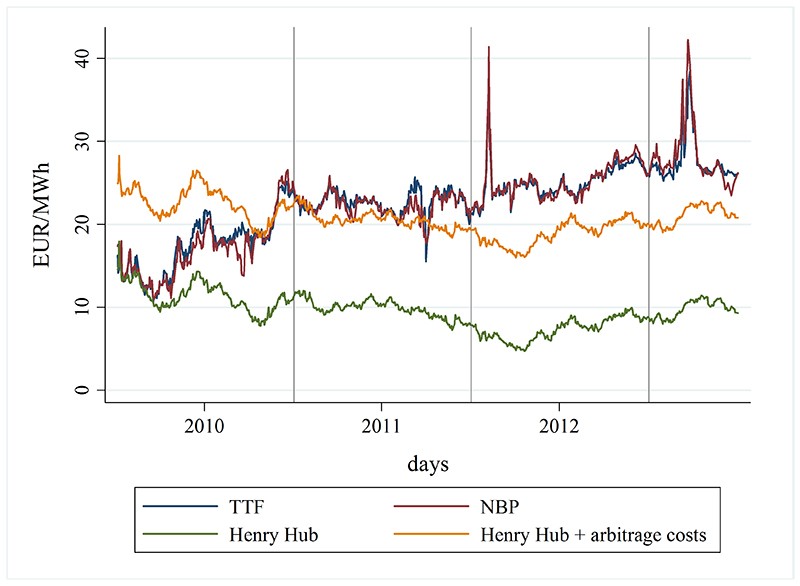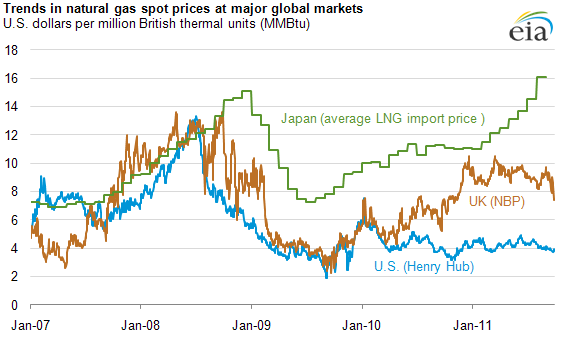How to Profit From Diverging Natural Gas Prices
Post on: 28 Май, 2015 No Comment

The price for natural gas here in the United States (priced at the Henry Hub) and the cost that the rest of the world pays (priced at the National Balancing Point in the U.K.) are diverging.
The graph on the right, courtesy of the U.S. Energy Information Administration and based on Bloomberg data, illustrates the growing divide between the two markets since mid-2009. This split is expected to increase in the near future as the United States and Europe head down separate paths in how they procure natural gas.
In order to understand potential opportunities for investors, one needs to explore the supply/demand dynamics both here and around the world
America: Awash in Natural Gas
Lets start with the United States. Its no secret that we have a newfound abundance of natural gas under domestic soil. Thats largely come about due to improved surveying techniques and the deployment of horizontal drilling and hydro-fracking technologies.
Its essentially put all the trillions of cubic feet of tight gas locked up in underground shale gas fields into play, making it both recoverable and economically viable to do so. The unlocking of shale gas has really become a positive black swan event for the future of U.S. energy policy.
Bottom line is this: Here in the United States, natural gas is plentiful, and it will remain relatively inexpensive for the foreseeable future.
Not only does the United States have an opportunity to achieve greater energy independence, but it also has the ability to export increasing quantities of natural gas to energy-hungry markets. Theres so much gas here, that nearly every Liquid Natural Gas (LNG) import terminal is now being retrofitted (or has plans in the works) to export LNG. With the divergence in price between the two markets, theres clearly money to be made by selling our cheap, abundant natural gas elsewhere in the world.
Recent events in Japan and the Middle East and soaring crude oil prices have Congress finally waking up to the idea that just maybe we could move away from oil imports and toward an increased use of natural gas.
Congress Introduces A New and Improved Natural Gas Bill
As evidence of this, a bipartisan group of Congressmen have introduced a new and improved natural gas bill to the floor. Congressmen Kevin Brady (R-TX), John Larson (D-CT), Dan Boren (D-OK) and John Sullivan (R-OK) have submitted H.R. 1380, the New Alternative Transportation to Give Americans Solutions (NAT GAS) Act.
Phew, thats a mouthful. The bill like its predecessor that was proposed and never went anywhere is intended to replace millions of barrels of foreign oil with domestic natural gas. That would be a real shot in the arm for the U.S. economy and job market. It would also put a real positive spin on Americas balance of trade, which fell $45.8 billion into the red in February 2011 alone.
The bills first focus is to convert fleet vehicles to natural gas engines. Congressman Sullivan highlighted that transportation is the primary driver of our dependence on foreign oil. Sixty-nine percent of the oil consumed in America is used for transportation, two-thirds of which we import from foreign nations, said Sullivan.
His colleague, John Larson, added: If we start making cars and trucks that run on natural gas, theres the potential to create over a half a million American jobs.
This bill may actually have a shot at passing since its endorsed by a large, bipartisan group of 76 Congressman and Senators, as well as President Obama. We must move America off OPEC oil and give our citizens some options at the fuel pump, said Congressman Boren. It is supported by some of the most progressive, as well as by some of the most conservative, members of Congress.
Financier and hedge fund chairman T. Boone Pickens even at the ripe old age of 82 must be doing back flips. Hes had the right idea for several years and has spent millions of his own money trying to convince the Beltway Boneheads that he has a really good idea. But I digress

Europe: Natural Gas in Great Demand and Tight Supply
In Europe, a much tighter coupling between the prices of oil and natural gas exists. European demand has been on the upswing and was particularly high this past winter, driving inventories downward.
Italy, for instance, imports most of the natural gas it uses, and much of that comes from Russia. In fact most of Europe has the uncertainty of supply associated with conventional supplies coming from Russias Gazprom (which has proven to be a finicky supplier in the past).
But the continent is also facing recent diversions of LNG cargoes to Japan to help offset the energy supply gap created by the downed Fukushima nuclear plant. Japan was already the worlds largest user of LNG, even before the disaster. However, the country will now be relying heavily on imports in order to fuel its rebuilding efforts.
What the Natural Gas Price Divergence Means to Investors
The divergence in price is extremely important because its closely monitored by spot suppliers of liquid natural gas. Spot suppliers of LNG are always looking to ship their liquid cargoes to the most profitable destinations, in order to maximize their profits. At the moment, the most profitable shipping destination for LNG is Japan. The country is desperate to replace the power it has lost due to the downed nuclear reactor.
Investors looking to make a play in the LNG market during this time of tight supply and growing demand might consider looking into companies that have the capacity to ship natural gas around the world in order to maximize on this run. Three companies to explore (at least until Japan replaces the power lost from Fukushima, a process that could be months or even years) are Frontline, Ltd. (NYSE:FRO ), Teekay Corporation (NYSE:TK ) and StealthGas, Inc. (NASDAQ:GASS ).
All three could benefit from higher world LNG prices in the wake of the Japanese disaster, growing European demand and policy changes in the United States. Keep in mind that once export terminals are up and running here in the United States, there will be even more lucrative investment opportunities in LNG.














